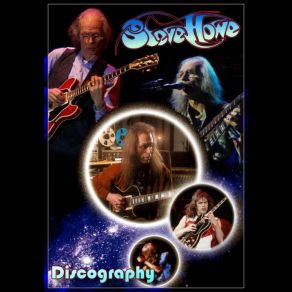Jon Anderson
Wikimp3 information about the music of Jon Anderson. On our website we have 46 albums and 41 collections of artist Jon Anderson. You can find useful information and download songs of this artist. We also know that Jon Anderson represents Rock genres.
Biography
[Edit]Born as John Roy Anderson on October 25, 1944, in Lancashire, England, Jon Anderson would grow up to become one of the most recognizable voices in progressive rock. He began his musical career by joining his brother Tony's group the Warriors. Eventually, that band relocated from England to Germany, however Tony had left the group by then. So, the only Anderson still in the band by 1965 when they cut their first single was Jon (technically still John at that time). The single received a less than enthusiastic welcome and Anderson left the group in 1967, having put in five years with them. His next move was to the group the Party, but that one was quite short-lived. By 1968, Anderson had returned to England and recorded two singles under the moniker Hans Christian Anderson. Those received responses similar to what the Warriors' single had. Anderson found his way into the group Gun, but only stayed there for a couple of months.
The year was 1968 and musical history was about to be made with an introduction in a London club. Jon Anderson was introduced to Chris Squire and finding a kindred spirit in music, he began showing up at gigs of Squire's band Mabel Greer's Toy Shop, whose guitarist at the time was Peter Banks. Anderson started getting up and singing with the group from time to time, eventually becoming their vocalist. However, Banks had left by the time Anderson was inducted. More pieces gradually began to fall into the mix as various musicians were brought into the Toy Shop fold. First Bill Bruford, then Tony Kaye. By the time Peter Banks returned, the band had decided to change their name to Yes. They released their first two albums in 1969 and 1970 and they received good critical response, but not a large commercial or radio presence. By the time that they recorded 1970's The Yes Album, the band had replaced Peter Banks with Steve Howe and the combination, along with a stroke of luck at a U.S. radio station, proved the charm to begin their commercial career. Interestingly, Anderson found the time for side projects even amidst recording and touring with Yes. In fact, he would show up on two albums in the first two years of the decade. The first was King Crimson's Lizard and the other was Johnny Harris' All to Bring You Morning. The next Yes album, 1972's Fragile, would feature both the debut of new keyboardist Rick Wakeman and the single "Roundabout." The combination propelled the group and Anderson well into the spotlight. For the next couple of years, Yes occupied the majority of Anderson's time. With the recording of three more studio albums before 1974 and steady touring, he would have little time for much else. However, after the tour for Relayer, things began to settle down a bit. Anderson managed to work with Vangelis Papathanassiou, who had been Yes' first choice for Rick Wakeman's replacement. Although immigration issues forced the band to go with Patrick Moraz instead, Anderson added vocals to the keyboardist's Heaven and Hell album released in 1975. It would definitely not be the last time they would work together.
1976 saw the entire band taking time to record solo albums. Anderson's outing, Olias of Sunhillow, was an ambitious creation. It was an album-long concept piece with nearly all the writing and performances being undertaken by the singer himself. He also added vocals to Yes drummer Alan White's Ramshackled album. The break seemed to revitalize the band and their next release, Going for the One, featuring the return of Rick Wakeman, was a very strong album and ushered the band into 1977 with style. Anderson's role in the group was close to coming to an end for a time, though. He stuck with them through the next album and couple of tours, but when they began recording for the follow up to Tormato, the dreaded "musical differences" cropped up and Anderson left. He definitely did not become idle, though. Indeed, the next couple of years proved very fertile for him. He released his second solo album, Song of Seven, in 1980. That same year, he collaborated again with Papathanassiou. This time they recorded an entire album together and released it under the moniker Jon & Vangelis. The album was called Short Stories, and they enjoyed that work so much that before the end of 1981, they released two more albums together. 1981 also saw Anderson appearing on Rick Wakeman's 1984 album. His next solo release was 1982's Animation, a show he took on the road.
1983 would be another turning point for Anderson. He worked on Mike Oldfield's Crises album, but that would not be the decisive factor in his career. By that time, Yes had been broken up for almost three years. Chris Squire and Alan White were working with a young guitarist named Trevor Rabin on a project called Cinema. Tony Kaye had also been enlisted for the project. Producer and one-time Anderson Yes replacement Trevor Horn suggested that Anderson should add some vocals to the project. Upon agreeing. Anderson remarked that with his voice on the songs it would be Yes. The group agreed and the name Cinema was dropped in favor of Yes. The resulting album, 90125, propelled by the hit single "Owner of a Lonely Heart," saw the band receive more success than they had ever previously attained. A tour ensued, but then the band had some quiet time. Anderson took the opportunity to record another solo album, this time a collection of holiday songs, entitled Three Ships. He also managed to work on a few other projects including movie soundtracks with John Paul Jones and Tangerine Dream. The next Yes album and tour in 1987 saw those musical differences once again appearing and Anderson again left Yes.
In the time following his second departure from the group, he released another solo album, this one a rather poppy collection entitled In the City of Angels. He also guested on Toto's release The Seventh One. By that time, he had begun talking with several Yes alumni about working together again. The group of them, Anderson, Steve Howe, Rick Wakeman, and Bill Bruford were joined by Tony Levin and completed an album. The only problem was deciding what to call the group. They had wanted to name it Yes, but Chris Squire proved ownership of that name and was not going to let them use it. So, they chose to forego cleverness and work with their last names. Thus their album was a self-titled one called Anderson- Bruford-Wakeman-Howe. The group toured fairly extensively for the release, but Anderson still wound up finding the time to contribute vocals to Jonathan Elias' Requiem for the Americas album. Another odd turn of events was looming on the horizon, though. As Anderson-Bruford-Wakeman-Howe were working on their second release, Yes was in the process of recording their next album. Lines of communication were once again opened and both projects were combined into one Yes album, dubbed Union. The group toured for the album to both filled stadiums and rave reviews. Anderson still found time to get together with Papathanassiou again and release the next Jon & Vangelis album, Page of Life, in 1991. The following year, he worked on Kitaro's album Dream. Among other projects, Anderson would do another album with Papathanassiou (Chronicles) and two solo albums (Deseo and Change We Must) before the 1994 release of the next Yes album, Talk. The lineup on that disc was back to a five-piece, Steve Howe, Rick Wakeman, and Bill Bruford having gone their separate ways.
The next couple of years were quiet ones for Yes, but not for Anderson. He made guest appearances on a few projects and released two new solo albums. And big things were once again on the horizon for Yes. It was announced in late 1995 that Trevor Rabin and Tony Kaye were no longer part of the group. They were replaced by alums Steve Howe and Rick Wakeman. A classic Yes lineup and incredible fan enthusiasm surrounded both the band and Anderson. The group did three shows in San Luis Obispo in March of 1996. The shows were recorded and released along with new studio material as the two Keys to Ascension albums. 1997 saw quite a bit more activity from Anderson. He released two solo albums, the Celtic The Promise Ring and EarthMotherEarth. Yes also released an album featuring his vocals. The disc was called Open Your Eyes and in true Yes tradition of revolving door membership, it did not feature Rick Wakeman, who had already left. Anderson went along with the group on a tour of small intimate theaters that fall. In 1998, he released his next solo album, The More You Know. That same year saw several releases featuring his vocal talents. Among them was 4Him's album Streams, Yes' The Ladder, and Steve Howe's Portraits of Bob Dylan. Touring and working on the Yes album Magnification have kept Anderson pretty busy, but he found time to appear on Béla Fleck & the Flecktones' 2000 release Outbound.
Title: Reason to Live
Artist: Jon Anderson
Genre: Gospel, Alternative Rock, Christian Rock, Christian Country Music, Pop, Alternative, Humor
Title: Live At the Apollo
Artist: Yes, Jon Anderson, Trevor Rabin, Rick Wakeman
Title: Open Your Eyes
Artist: Yes, Jon Anderson, Billy Sherwood, Steve Howe, Chris Squire, Alan White
Genre: Rock
Title: Sunshine State Presents:
Artist: FEVER, Loleatta Holloway, Jon Anderson, Undercover, Sunshine State, Booker Newberry III, Daz, Aquilla, Lisa Michaelis, Cie
Genre: Dancefloor, Dance Pop
Title: BOFM Boomers
Artist: FEVER, Loleatta Holloway, Jon Anderson, Undercover, Tippa Irie, Philip Bailey, Sunshine State, Aquilla
Genre: Dancefloor, Pop, Dance Pop
Title: In Elven Lands / The Fellowship
Artist: Jon Anderson, Carvin Knowles
Genre: Progressive Rock, Pop Rock
Title: Song Of Seven (Remastered & Expanded Edition) - 1980
Artist: Jon Anderson
Genre: Progressive Rock, Progressive Metal
Collections
Title: Lost Soul & R&B
Genre: Hip Hop/R&B, Soul
Title: Jazz and the Philharmonic
Genre: Jazz
Title: Old Testament: Make Me to Know
Genre: Gospel
Title: Hot Topics: Let No One Despise Your Youth
Genre: Gospel
Title: Luther & the Small Catechism: Faith History
Genre: Gospel
Title: Lutheran Life: I Will Sing
Genre: Gospel
Title: The Life of Jesus: These Are Written
Genre: Gospel
Title: New Testament: New Creation
Genre: Gospel
Title: The Lord's Prayer: Our Father
Genre: Gospel
Title: Sound of Poetry
Genre: Pop
Title: Coffee House Blend (Re-Recorded Versions)
Genre: Pop
Title: Bible Song: The Good News
Title: Chill Out Zone 98 - Influence
Genre: Electro
Title: Greatest Synthesizer Hits (CD3)
Genre: Ambient, Electronica, World Music
Title: St. Elmo's Fire (Original Soundtrack)
Genre: Theatre/Soundtrack
Title: Your Greatest Hits 80s (Joe FM Top 800 Volume II) (CD2)
Genre: Pop
Title: Rock Ballads Vol 2 (CD2)
Genre: Rock
Title: Classic Progressive Rock
Genre: Rock, Progressive Rock, Punk Rock, Progressive Metal
Title: Prog Rock Essentials 2021 (CD2)
Genre: Progressive Rock, Progressive Metal
Title: Prog Rock For Rookies 2023
Title: Prog Rock For Rookies Vol. 2
Title: Progressive Artistry 2023
Genre: Rock, Progressive Rock, Punk Rock
Title: Underground Rock Art (CD1)
Title: Underground Rock Art (CD2)
Title: Rock Prog: Crossing Borders Vol. 02 (CD1)
Genre: Rock, Punk, Punk Rock, Alternative
Featuring albums
Title: Heaven & Hell
Artist: Vangelis
Genre: Ambient, New Age, Electronica, Rock, Dancefloor, Dance Pop, Progressive
Title: The Futurist
Artist: Robert Downey Jr.
Genre: Rock, Folk Rock, Punk Rock, Pop, Alternative, Songwriter/Lyricist, Classical
Title: Peaceful Warrior (Original Motion Picture Soundtrack)
Artist: Dan Millman
Genre: Theatre/Soundtrack
Title: Symphonic Music of Yes
Title: Metropolis - Original Motion Picture Soundtrack
Artist: Original Motion Picture Soundtrack
Genre: Electronica, Techno, Dancefloor, Pop
Title: The Ultimate Kitaro Collection : Silk Road Journey
Artist: Kitaro
Genre: New Age, World Music
Title: 20th Anniversary (1980 - 2000) CD2
Artist: Café Del Mar / Cafe Del Mar
Genre: New Age, Electronica, Hip Hop/R&B, Dancefloor, DJ/Remixes, Pop, Dance Pop
Title: The Friends Of Mr. Cairo
Genre: New Age, Electronica, Rock, Dancefloor, Pop, Pop Rock
Title: Gift
Artist: Vangelis
Genre: Ambient, New Age, Electronica, Rock, Dancefloor, Pop, Pop Rock, Synth Pop, Experimental, Classical
Title: Legend
Artist: Tangerine Dream
Genre: Ambient, New Age, Electronica, Rock, Theatre/Soundtrack, Classical
Title: Light Walls (CD1)
Artist: Steve Howe
Genre: New Age, Instrumental Rock, Progressive Rock, Progressive Metal, Psychedelic
















































































































